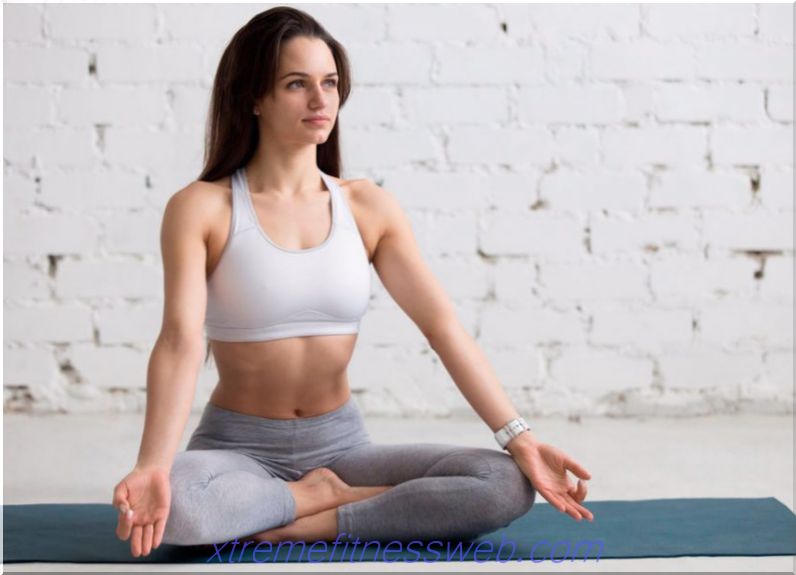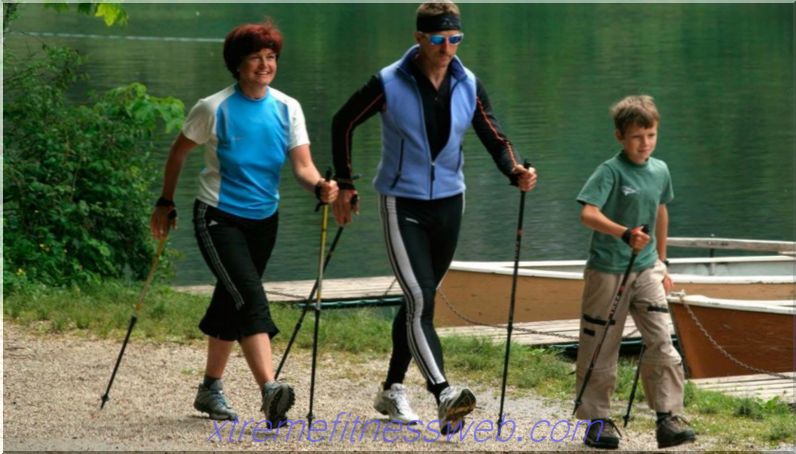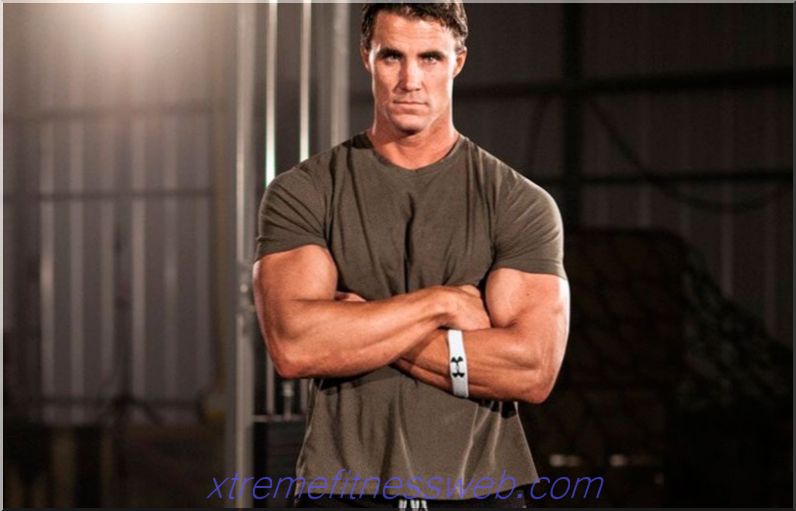
In order to qualitatively improve the endurance and strength of the back muscles, you need to know that all the muscles of this part of the body are divided into two categories: superficial and deep . The muscles passing close to the skin include trapezius and latissimus, the dentate muscle and rhomboid muscles belong to the deeper-lying muscle tissue.
When pumping back muscles, it is not recommended to perform exercises aimed at working out the back of the body, with loads designed for legs and arms. If necessary, you can combine back exercises with press loads and “deltas” (shoulder muscles). Performing exercises aimed at increasing the strength of the spinal muscles should always be carried out after a quality warm-up and several sets of basic actions.
Content
- 1 Deadlift
- 2 tilt rod
- 3 Dumbbell Dumbbell
- 4 Shrugs
- 4.1 Shrugs standing
- 4.2 Shrugs lying
- 5 thrust block to chest
- 6 thrust block to the stomach
- 7 Hyperextension
Deadlift
 Deadlift is one of the basic exercises from among those aimed at working out the spinal muscle tissue. This complex loads many joints and additionally pumps all the major muscle groups.
Deadlift is one of the basic exercises from among those aimed at working out the spinal muscle tissue. This complex loads many joints and additionally pumps all the major muscle groups.
- To perform the exercise, it is necessary to stand in front of the barbell in the “socks shoulder width” position (you can also choose a pose with a narrower leg distribution). After taking the starting position, you must bend down and take the barbell with your hands, while the brushes should have exactly the same width as the distance between the shoulders.
- At the beginning of the upward movement, weight lifting occurs due to the work of the muscle tissues of the legs, the back remains motionless. In the second phase of the exercise, the back muscles come into play, and it is at their expense that it is necessary to push the bar to the groin.
- After the projectile is in the lumbar region, it is necessary to lower the barbell to the floor exactly along the same trajectory along which the lift was carried out.
Inclined rod pull
 The following exercise is performed mainly for the load on the “trapezium” and the broadest muscle tissue of the back, and biceps and posterior deltoid muscles are also involved in the process.
The following exercise is performed mainly for the load on the “trapezium” and the broadest muscle tissue of the back, and biceps and posterior deltoid muscles are also involved in the process.
- Prepare for the exercise as follows: put your legs at a comfortable distance and bend your knees.
- It is necessary to start lifting the bar with a direct grip of the hands, without bending them at the knee joints. To raise the training apparatus was easier, it is necessary to bend to the bar at an angle approximately equal to 30 degrees.
- After tilting forward, it is necessary to bend forward in the lower back and bring the barbell to the level of the knees, after which, using tension of the lumbar muscle tissue, the projectile is brought into the abdomen. When lifting from knees to the abdomen, special attention should be paid to the work of the back muscles: many beginners make a mistake by lifting the bar with biceps, as a result of which the beneficial effect of the action is reduced to zero.
- After the bar is raised to the level of the abdomen, it is necessary to fix it at the achieved height for several seconds, after which the projectile is returned to the floor along the same path.
Dumbbell Dumbbell
 Dumbbell traction in an inclined position allows you to maximize the use of the lower part of the broadest muscles, which, when performing other exercises, is worked out slightly less than all other muscle tissue groups. Compared to lifting a dumbbell in a normal position, the tilt option allows you to lift the projectile to a great height and reduces the load on the vertebrae.
Dumbbell traction in an inclined position allows you to maximize the use of the lower part of the broadest muscles, which, when performing other exercises, is worked out slightly less than all other muscle tissue groups. Compared to lifting a dumbbell in a normal position, the tilt option allows you to lift the projectile to a great height and reduces the load on the vertebrae.
- Before the exercise, you can try two starting positions and decide which one is better. The first option: put the left lower leg and knee on the bench and rest against it with the left hand, after which the right hand goes back. The second option: both legs are on the floor, while the left is in front of the right and bends at the knee joint, after which the left hand rests on the bench, and the body is brought into an inclined position.
- It is necessary to start the exercise with a neutral grip of the dumbbell. After capturing the projectile with your free hand, the dumbbell is lifted to the blades (or higher) in an arc, at the top point the dumbbell is fixed for 2-3 seconds, after which it returns.
When lifting the dumbbell in an incline, you need to monitor the position of the body (it should not be turned to lift the dumbbell to the highest possible height), it is also worth paying attention to the elbows (they must be firmly fixed in the initial position).
Shrags
Shrugs - lifting shoulders with a load, performed to improve the strength of the "trapezoid". This exercise is difficult for beginners, so experienced instructors recommend starting the scars only after a few months of intensive training. There are two techniques for performing a shrag, differing in the positions in which actions are performed.
Shrugs standing
 To perform the shrag in the “standing” position, it is necessary to choose a shell with a curved neck: such a bar will reduce the load on the inguinal muscles and legs.
To perform the shrag in the “standing” position, it is necessary to choose a shell with a curved neck: such a bar will reduce the load on the inguinal muscles and legs.
- To perform a scar, it is necessary to stand up as in a deadlift with a bar already in hand.
- The exercise begins with lifting the shoulders to the highest possible height. The movement of the bar is controlled exclusively by "trapezoid", no other systems of muscle tissue in the exercise are worked out.
- After reaching the top point, it is necessary to lower the projectile and repeat the cycle for several tens of seconds.
When performing the exercise “shrugs standing” you can not make rotational movements of the muscles - this can lead to damage. If you do not have enough strength or preparation to complete several cycles, you need to put the stands on the lower position of the stand and put a projectile on them in case the muscles can not keep the projectile in a given position.
Shrugs lying
- The initial position is lying on a horizontal bench with feet standing on the floor. Limiters for the bar are installed 10 cm below the level at which the point corresponding to the full extension of the arms in the elbow joints is located.
- Putting your hands to the width of your shoulders, grasp the projectile and push it up, pressing your shoulders to the bench and squeezing the shoulder blades as much as possible.
- When you exhale, the shoulder blades move away from each other, and the shoulders rise from the bench.
- When you inhale, you are returned to the previous position.
When performing a shrag lying, it is necessary to pay special attention to the position of the head (it is forbidden to tear it and the upper back from the bench).
Chest pull
 Pull-ups were taken as the basis of the block’s thrust to the chest: during the exercise, the same actions are performed as when lifting one's own weight on the horizontal bar.
Pull-ups were taken as the basis of the block’s thrust to the chest: during the exercise, the same actions are performed as when lifting one's own weight on the horizontal bar.
- In preparation for the exercise, you must sit on the seat and grasp the handles of the block (if they are too high, you need to adjust the projectile).
- Reducing the shoulder blades, you need to lower the block to about chest level.
- After lowering, the block immediately but smoothly returns to its original position.
To remove the load from the biceps and concentrate exclusively on the back muscles, it is necessary to use the open type of grip of the handle. Elbows when lowering and raising the machine move in the same plane without moving horizontally.
Block pull to stomach
 The attraction of the block located near the floor is aimed at the development of muscle tissue "deltas", the latissimus muscles and forearm.
The attraction of the block located near the floor is aimed at the development of muscle tissue "deltas", the latissimus muscles and forearm.
- The starting position is sitting facing the simulator with the handles in the hands. To start the exercise, you need to pull the block towards yourself, while the body deviates slightly, the back is tense, and the biceps are completely relaxed.
- When performing the exercise, it is necessary to attract and repel the block as accurately as possible, the main attention is paid to maintaining the back in the initial position.
- With the closest possible position of the block, the blades should be almost completely reduced.
- To return to the starting position, you need to straighten your arms and hold the handle a little to maintain smooth movements.
When pulling the block to the stomach, the back should not be rounded, repetitions should be rhythmic and performed in approximately the same time.
Hyperextension
 Hyperextension is an exercise that strengthens the muscles of the lower back. The load when performing hyperextension lies mainly on the biceps of the hips, extensors of the back and muscles of the buttocks. Hyperextension allows, among other things, the development of very small spinal muscle tissues, which are not amenable to study by any other actions. Although hyperextensions are not aimed directly at working out the back muscles, their inclusion in the training plan is necessary: a strong lower back is the key to the quality of deadlift and other complexes, without which the creation of strong back muscles is impossible.
Hyperextension is an exercise that strengthens the muscles of the lower back. The load when performing hyperextension lies mainly on the biceps of the hips, extensors of the back and muscles of the buttocks. Hyperextension allows, among other things, the development of very small spinal muscle tissues, which are not amenable to study by any other actions. Although hyperextensions are not aimed directly at working out the back muscles, their inclusion in the training plan is necessary: a strong lower back is the key to the quality of deadlift and other complexes, without which the creation of strong back muscles is impossible.
- The initial position - the upper rollers are opposite the upper part of the hips, the lower ones - at the level of the ankles or slightly higher.
- The exercise begins with the establishment of the feet between the rollers and fixing the hands on the chest in the "criss-cross" position.
- After completing the preparation, it is necessary to lean forward with rounding of the back, after reaching an angle of 60 degrees, it is necessary to fix the body for a short time in this position, and then return to the initial position.
You should not go down to the floor - it will not give efficiency in working out the muscles of the lower back, and additional loads will turn out to be very significant. At the top of the lift, you should not bend backward - this increases the risk of spinal stretching and damage.







